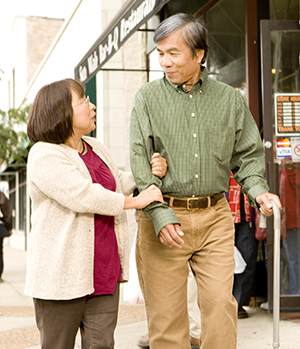Having had a stroke, your loved one is at higher risk of having another one. Medicine, exercise, and diet are keys to reducing this risk. Your loved one needs to be active each day. If they are able, walking is a good way to get daily exercise. Ask their healthcare provider for an exercise plan. This information will help them increase their strength and endurance in a safe way. You might also ask the provider to refer your loved one to a dietitian. This provider specializes in nutrition. If your loved one smokes, talk to them about quitting. Ask their provider for help. It's also important to manage other health problems such as high blood sugar (diabetes), high blood pressure (hypertension), and high cholesterol.
Taking medicine
Your loved one may take more than one type of medicine. Each must be used as directed. If medicines include a blood thinner, your loved one may need regular blood tests.
Tips for safe medicine use
-
Make sure medicines are taken on schedule. If timing is vital, set an alarm.
-
Keep pill doses in a divided tray. A pill box can help.
-
Know which foods or liquids the person should not have while taking prescribed medicines.
-
Ask the pharmacist or provider for assistance if the medicine schedule is confusing or overwhelming.
Reducing the risk for stroke
Many factors that increase the risk for stroke can be reduced. Always ask for help if you have questions or concerns about any issues related to stroke prevention. Your loved one’s healthcare team can advise ways to:
-
Lower high blood pressure
-
Improve cholesterol
-
Control heart disease
-
Manage diabetes
-
Lose excess weight
-
Reduce the risk for blood clots by taking blood thinners as advised by the provider
-
Stay active with aerobic and muscle-strengthening exercises
-
Stop smoking
When to call 911
If your loved one suddenly has any of the problems below, call 911 right away for emergency medical help:
-
Numbness or weakness of the face, arms, or legs, especially on one side
-
Confusion or trouble speaking or understanding
-
Trouble seeing in one or both eyes
-
Trouble walking, dizziness, or loss of balance or coordination
-
Severe headache with no known cause
-
Loss of consciousness or a seizure
Do not drive if you or someone else has these symptoms. Emergency medical services (EMS) workers can alert the hospital and start treatment.
B.E.F.A.S.T. is an easy way to remember the signs of a stroke. When you see these signs, you'll know that you need to call
-
B is for balance. Sudden loss of balance or coordination.
-
E is for eyes. Vision changes in one or both eyes.
-
F is for face drooping. One side of the face is drooping or numb. When the person smiles, the smile is uneven.
-
A is for arm weakness. One arm is weak or numb. When the person lifts both arms at the same time, one arm may drift downward.
-
S is for speech difficulty. You may notice slurred speech or trouble speaking. The person can't repeat a simple sentence correctly when asked.
-
T is for time to call
911. If someone shows any of these symptoms, even if they go away, call911 right away. Make note of the time the symptoms first appeared.


